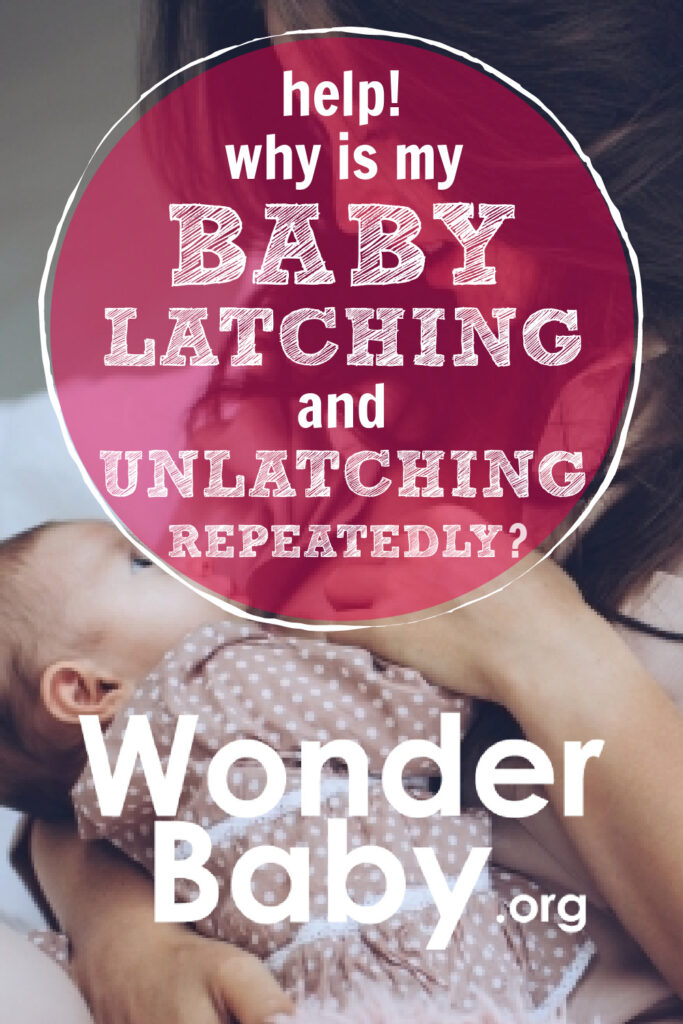Help! Why is My Baby Latching and Unlatching Repeatedly?

- Your baby might be unlatching repeatedly for many reasons—including gas, illness, teething, or being distracted.
- Determine if you have an issue with poor latching, low milk flow, or too much milk supply, which can contribute to your baby latching and unlatching repeatedly.
- You can remedy many of these issues by finding the right solution for the problem, achieving a deep latch, or seeking help from a professional lactation consultant.
- If problems persist, it’s best to see your baby’s pediatrician.
Are you struggling with your baby unlatching multiple times per feeding session? When she unlatches, does she squirm and act uncomfortable or fussy? Does she unlatch while gulping milk or pull away to gasp for air?
These are all common symptoms in babies that struggle with latch issues. Determining the reason behind it can take some work.
When your baby repeatedly unlatches, it can be worrying and quite frustrating. Not to mention painful for your nipples.
Don’t worry! This issue is very common, and we have solutions to help make breastfeeding your baby the peaceful, healthy bonding experience it should be.
Why is My Baby Latching and Unlatching Repeatedly?
Fast Letdown
A fast letdown is when your milk supply flows quickly and forcefully out of the breast. This can be overwhelming for your baby, who may be struggling to keep up with the fast milk flow and unlatches to get a break. Imagine trying to drink from a fountain gushing water into your mouth. You would feel overwhelmed and pull away.
Having a fast letdown is out of your control. Many women naturally have a high milk flow. And this is often amplified when you haven’t nursed or pumped in a while and have a lot of milk stored up.
Solution for a Fast Letdown
One solution is to get milk flowing by pumping, or by hand, a few minutes before nursing your baby. This will express the foremilk, which might not be as filling or nutritious as the hindmilk that comes towards the end.
Another option is nursing in a laid back position with your baby on top of you. This gives your baby more control over her nursing session. It also has the milk flow going against gravity, discouraging the breast milk from gushing out.
Nursing in a reclined position also allows excess milk to spill out the sides of your baby’s mouth (have a towel ready). It’s helpful in relieving some of the pressure off her to gulp fast.
Slow Flow
Contrary to the situation above, having a low milk supply or slow milk flow can be the culprit of your baby’s tendency to unlatch.
If you notice that your baby tugs at your nipples in frustration or is hungry shortly after eating, she may be getting less milk than she needs. If your baby is not getting a good flow of milk, she will instinctually unlatch and try again for a deep latch.
Solution for a Slow Flow
If your baby struggles on one breast, try switching to the other side. If she’s fine nursing on one side but starts unlatching, see if she’ll be happier on the other breast. If your baby does have a good latch and is getting enough milk, don’t switch breasts until your baby shows you that she’s finished with that side.
Breast compressions at the top of the breast can also encourage milk to flow down. It’s best to compress while the baby is sucking, and avoid compressions when the baby is not sucking.
Decreased Milk Production
Massaging the breasts and frequent nursing can also help if you find you’re producing too little milk. Certain supplements, like postnatal vitamins specifically formulated for milk production, are another good option to try. Always consult with your pediatrician or lactation consultant before taking any supplements or medication.
Gassiness
Gas can be a big issue and quite unpleasant for babies (especially for a newborn baby), as their digestive systems adjust to eating and processing food for the first time.
If you notice your baby unlatching to burp, fart, poop, or do a lot of squirming around—gas could be preventing them from having a smooth nursing session. Often swallowing too much air while nursing can cause stomach discomfort, thus adding to your baby’s fussiness.
Solution for Gassiness
Frequent burping sessions while nursing, not just after, releases trapped air. If your baby unlatches, that’s an excellent opportunity to see if he’ll burp. Repeat this if you switch sides and after he finishes eating. Try different burping positions, like these:
- Over your shoulder: This is the traditional burping position. Often it’s helpful to walk around and gently bounce up and down while you pat and rub your baby’s back.
- Sitting on your lap: Sit your baby on your lap, facing away from you in an upright position. Lean your baby forward and pat lightly on her back. Use your hand to support her chest, ensuring her neck and head are supported.
- Lying across your lap: Lay your baby tummy down across your lap—supporting her chin without any pressure on the throat. Many babies prefer this position because it gently compresses their belly, allowing them to wiggle to release trapped air.
Try a variety of gas moving exercises, like pushing her knees into her chest and slowly rotating them clockwise, stimulating the natural flow and direction of the large intestine. Bicycle kicks and tummy time help expel gas too.
Many moms have great success with gas drops and gripe water, and they’re worth trying if your baby’s gas continues.

Distractions
At around 12 weeks, your baby is developing mentally at a rapid pace, becoming aware of his surroundings. A distracted baby may unlatch because he notices dad’s voice, the TV, or other people passing by.
Sometimes babies use the breast as a distraction, like a pacifier. They may be enjoying the activity and comfort nursing, even though they’re not hungry. When the milk starts flowing, they don’t want it and unlatch.
Solution for Distractions
While it’s not always possible, try to nurse in a quiet room with limited distractions. Keep the environment familiar and return there for every feeding to keep your baby focused.
For babies using breastfeeding as a pacifying activity, it might be time to introduce a pacifier. Or you can try to distract her with another toy or activity.
Teething Baby
Teething can cause discomfort and sensitivity. Nursing can worsen gum pain and make your baby uncomfortable.
Solution for Teething Babies
Most teething pain subsides naturally in a couple of days. Consult with your pediatrician about whether Children’s Tylenol can be used with your baby if she is particularly troubling teething pain that prevents her from eating.
Sick Baby
When your baby latches on, he has to breathe through his nose to nurse. Breastfeeding a sick baby with nasal congestion can make feeding challenging and may lead to shallow latch or unlatching repeatedly.
Solutions for Breastfeeding a Sick Baby
To help breastfeed a baby with a stuffy nose, you’ll need to try to keep her nose as clear as possible. One option is to use nasal saline drops several times a day. A bulb suction tool like a NoseFrida will help to clear out her nose before you nurse.
Try running a humidifier in your baby’s room to help loosen mucus and make it easier to expel. During feedings, feed her at an incline or upright so that any mucus she dislodges will move down as she swallows.
When to See a Doctor
If the problem persists, visit your baby’s pediatrician as soon as possible. They’ll check to see if there’s an anatomical reason for her unlatching—like a tongue tie or lip tie. Also, sometimes very large or inverted nipples can make it challenging to get your baby to latch on.
Although rare, you may ask your doctor to check for silent reflux, a condition in which stomach acid flows back up the esophagus, causing discomfort.
A professional lactation consultant and your child’s pediatrician can provide guidance for mothers of children with visual impairments or other disabilities.

Nursing Positions to Prevent Your Baby From Latching and Unlatching Repeatedly
Sometimes switching up your nursing position can help to stop your baby from latching and unlatching during feedings. Here are some nursing positions to try:
- Cross-cradle: This position is ideal for newborn babies. Sitting in a comfortable chair, cradle your baby’s head in the crook of your arm with his belly against yours.
- Cradle hold: Similar to the cross-cradle, your baby is propped up on the same side as the nursing breast. With newborn babies, it’s good to use a nursing pillow for support.
- Football hold: Slide your baby to your side with her legs tucked under your arm (like you would hold a football) on the same side as your nursing breast.
Premature or smaller babies, mothers of twins, and mothers with large breasts have a lot of success with the football hold position.
- Laying back: A laid back position lets gravity do the work to allow babies latch to happen organically. A good latch leads to less unlatching. This position is especially beneficial for mothers with smaller breasts.
- Laying on your side: This is a great, relaxing breastfeeding position. Lay down with your baby on her side, facing you. This position is good if your baby is experiencing gas pain and needs to stretch out.
It’s important to be wary of extra bedding and the suffocation hazard it poses. Make sure to keep blankets and loose materials away from your baby.
Breastfeeding can be challenging. Don’t let the frustration get to you and don’t give up! Take a break when your baby’s unlatching starts to overwhelm you and stress you out.
Use an ointment for sore nipples and explore different breastfeeding positions if you’re experiencing a lipstick nipple or shallow latch.

Related Posts

Breastfeeding, Sleep
Sleep and Breastfeeding: A Comprehensive Guide for Nursing Moms
Many people assume breastfeeding and sleep training don’t go together, but it is possible to help your baby sleep better while continuing your breastfeeding journey.

Breastfeeding
Comfort Nursing: Pros, Cons, and How to Stop
Find out what comfort nursing is, when should you worry about it, and how to stop or limit your baby's comfort nursing (especially at night!).

Breastfeeding, Product Reviews
5 Best Breastfeeding Chairs for Nursing Moms of 2023
Whether you want a gentle rock, a smooth glide, or a cozy cuddle to soothe your baby to sleep, you’ll have your pick of the best breastfeeding chairs on the...